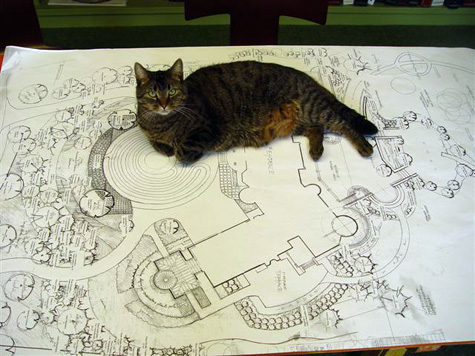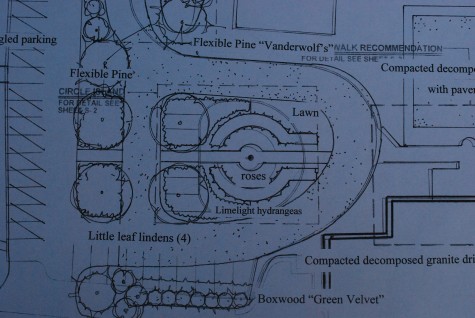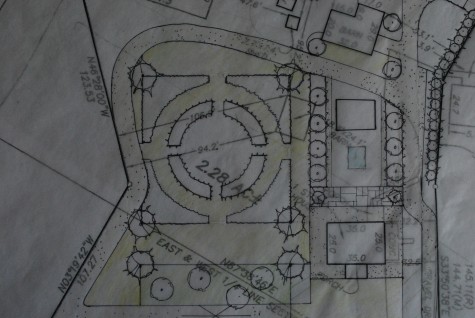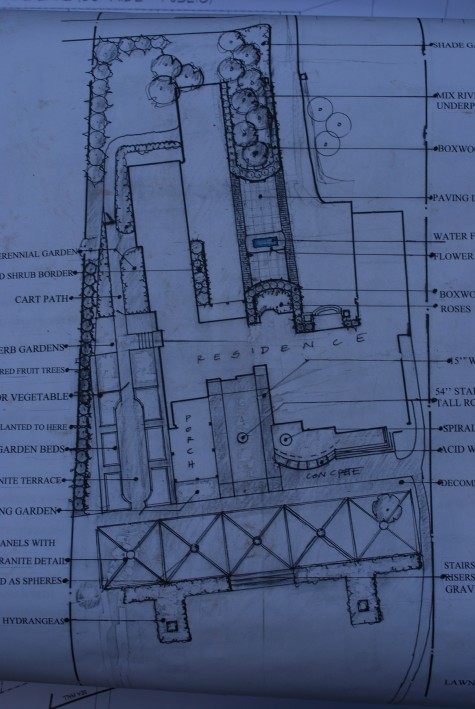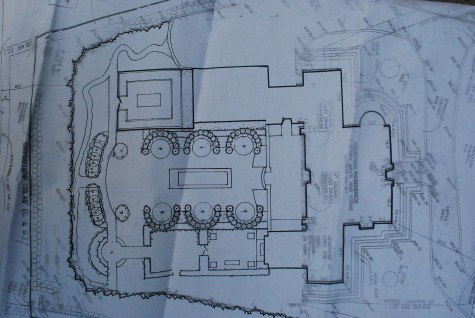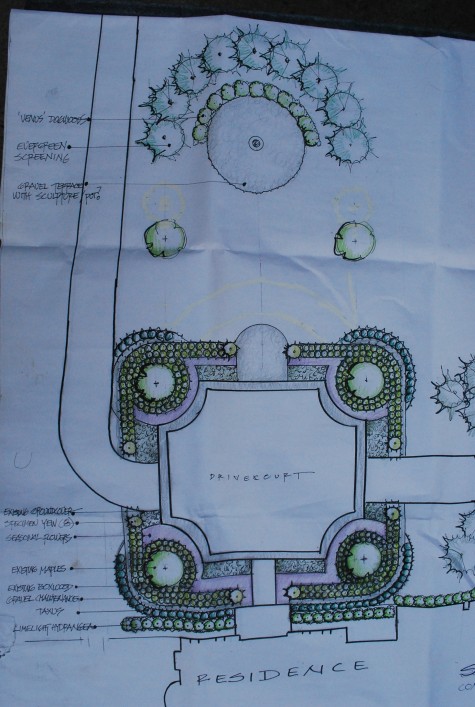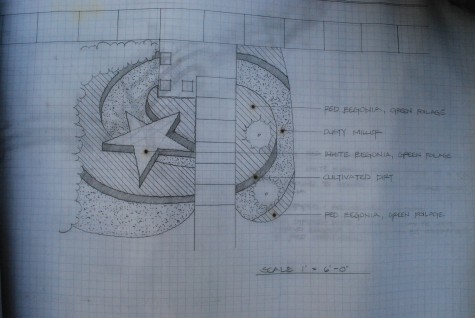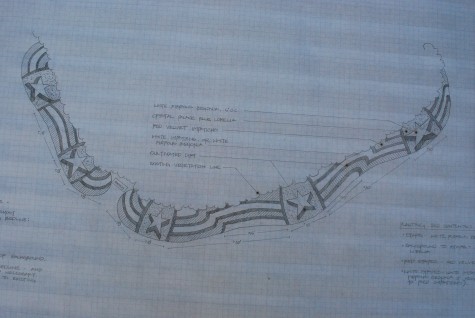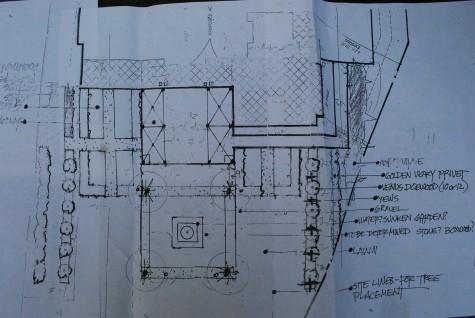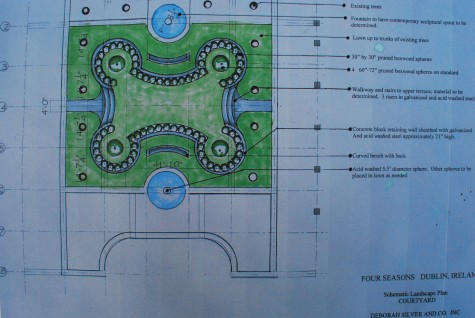At A Glance: Drawings
The Big Picture
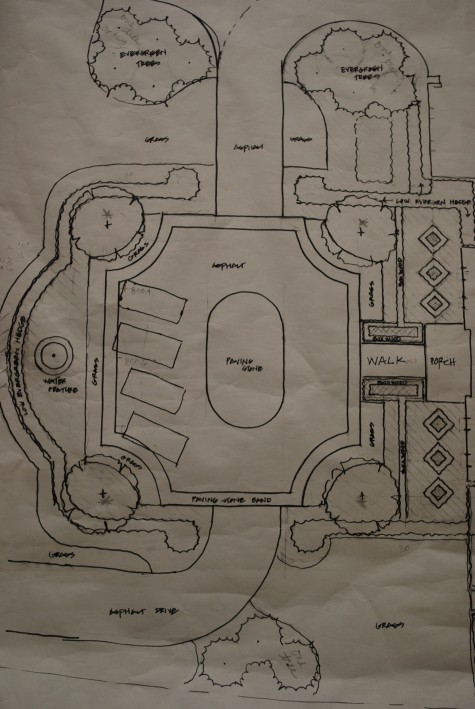 I have been consulting with a client who has an existing landscape. They know it is unfinished, and unresolved. They gave me their drawing in tandem with a request. We cannot really explain what is not working here, but can you help us get a little room for something colorful and lively? I plan to help them. So what do I not like about this drawing? The drawing is not color coded. I can read lines, but I do this for a living. A group of lines-not friendly to a client. Would it not be good to differentiate the like trees from the grass from the like and the different shrubs? A landscape drawing may make me think about the artful signature that is a line-but a landscape schematic needs to explain clearly its idea to its intended. Where is the house? What part is the driveway, and what part is the living landscape? Where will the tulips go? Four rectangles at an angle strongly suggest the parking scheme-at least to me. But where is the living and breathing part? Where in this drawing is what will make architecture and nature intersect, beautifully? Everyone wants to come home, and be glad for where they live-a good landscape plan fosters this. A clearly drawn plan will show if this is working, or not.
I have been consulting with a client who has an existing landscape. They know it is unfinished, and unresolved. They gave me their drawing in tandem with a request. We cannot really explain what is not working here, but can you help us get a little room for something colorful and lively? I plan to help them. So what do I not like about this drawing? The drawing is not color coded. I can read lines, but I do this for a living. A group of lines-not friendly to a client. Would it not be good to differentiate the like trees from the grass from the like and the different shrubs? A landscape drawing may make me think about the artful signature that is a line-but a landscape schematic needs to explain clearly its idea to its intended. Where is the house? What part is the driveway, and what part is the living landscape? Where will the tulips go? Four rectangles at an angle strongly suggest the parking scheme-at least to me. But where is the living and breathing part? Where in this drawing is what will make architecture and nature intersect, beautifully? Everyone wants to come home, and be glad for where they live-a good landscape plan fosters this. A clearly drawn plan will show if this is working, or not.
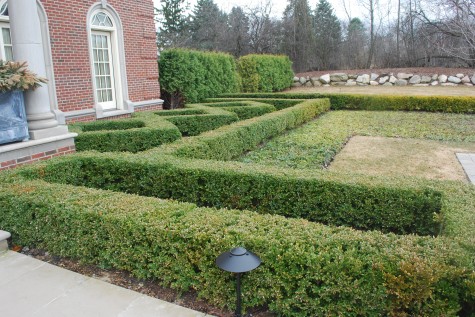 My client has no end of boxwood-strikingly well grown, and maintained. Miles and miles of it. Well grown plants do not necessarily make a coherent and beautiful landscape-I tell them. I have plenty of personal experience. My perfectly grown clematis, the hybrid known as Sho-Un, was planted in a spot the most rank amateur gardener would avoid-what was my problem? Five years later, I had to move it-and in moving it, I killed it. I understood my clients concern about changing up many miles of beautifully grown plants., but in this case, I think it is worth the trouble.
My client has no end of boxwood-strikingly well grown, and maintained. Miles and miles of it. Well grown plants do not necessarily make a coherent and beautiful landscape-I tell them. I have plenty of personal experience. My perfectly grown clematis, the hybrid known as Sho-Un, was planted in a spot the most rank amateur gardener would avoid-what was my problem? Five years later, I had to move it-and in moving it, I killed it. I understood my clients concern about changing up many miles of beautifully grown plants., but in this case, I think it is worth the trouble.
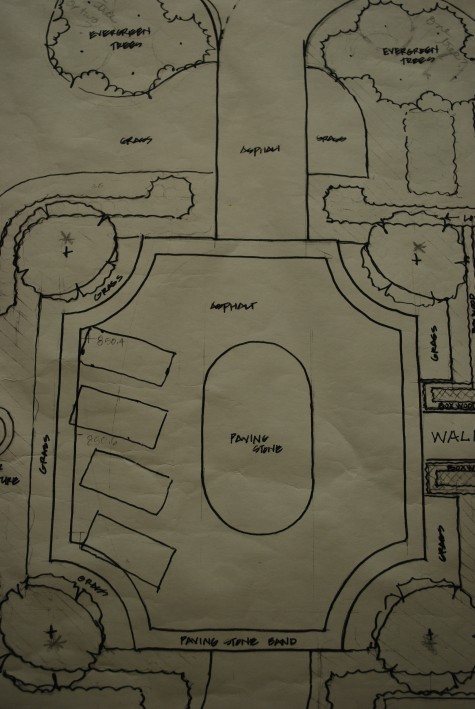 The dominant feature of this entry landscape drawing is a drivecourt of monumental proportions. I could stage a rock concert here, or a reception for four hundred people, and have room to spare. As much as I admire its bold scale, it seems natural to key the landscape elements in recognition and reinforcement of the shape it describes. There will be no ignoring it. It is large enough that a landscape feature could exist in that oval of paving stone, and not obstruct traffic in the least.
The dominant feature of this entry landscape drawing is a drivecourt of monumental proportions. I could stage a rock concert here, or a reception for four hundred people, and have room to spare. As much as I admire its bold scale, it seems natural to key the landscape elements in recognition and reinforcement of the shape it describes. There will be no ignoring it. It is large enough that a landscape feature could exist in that oval of paving stone, and not obstruct traffic in the least.
 This photograph may give you a better idea of the drivecourt square footage in question. The center oval detailed in a different material from the rest of the asphalt drive was a good move. Nonetheless, we are looking at a giant space here. A sweeping move of this scale needs friendly and solid company. The existing landscape pays no mind, does not follow up a gesture of this scale. The drivecourt as it stands-lonely. The boxwood look very small, and not as visually important as they should. Some larger growing plant element backing up that boxwood will add weight and visual heft.
This photograph may give you a better idea of the drivecourt square footage in question. The center oval detailed in a different material from the rest of the asphalt drive was a good move. Nonetheless, we are looking at a giant space here. A sweeping move of this scale needs friendly and solid company. The existing landscape pays no mind, does not follow up a gesture of this scale. The drivecourt as it stands-lonely. The boxwood look very small, and not as visually important as they should. Some larger growing plant element backing up that boxwood will add weight and visual heft.
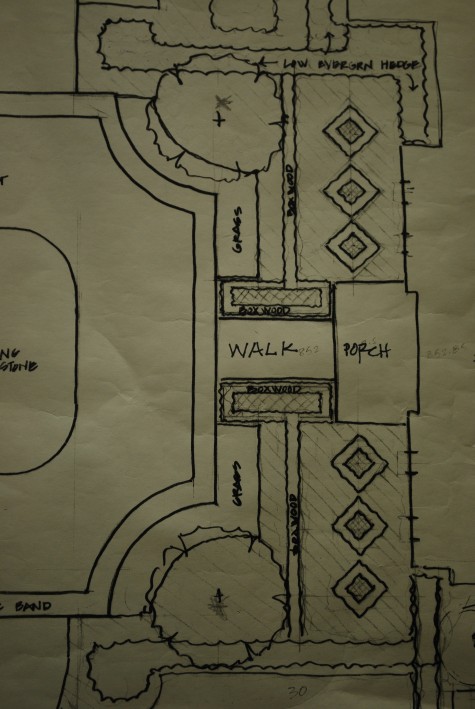 The walk to the front door needs to set a mood. Hello, and welcome to my home-this idea does fine, for starters. Beyond the welcome, that walk should represent a distinctive and strong hello. A house is a very large object; the landscape should help sit that structure down onto the land.
The walk to the front door needs to set a mood. Hello, and welcome to my home-this idea does fine, for starters. Beyond the welcome, that walk should represent a distinctive and strong hello. A house is a very large object; the landscape should help sit that structure down onto the land.
 These gorgeously grown diamonds of boxwood are just that-gorgeously grown diamonds. This shape and configuration is outside the language established by the architecture of the house, and its attendant drivecourt. The drivecourt, in my mind, is all about beautiful curves, and not much about diamonds. What will I do with these boxwood diamonds?
These gorgeously grown diamonds of boxwood are just that-gorgeously grown diamonds. This shape and configuration is outside the language established by the architecture of the house, and its attendant drivecourt. The drivecourt, in my mind, is all about beautiful curves, and not much about diamonds. What will I do with these boxwood diamonds?
 The original drawing is focused on the drivecourt, with no indication of how that landscape would sit on the property as a whole. My perspective? Every landscape composition needs to be detailed with all the edges in evidence. The foreground space implies a midground space-and a far view. I orient my drawings to the primary view-from the front door out. I redrew their landcape plan in an effort to make the house, drivecourt and landscape more harmonic, and less fussy. What would you want to see every day? My idea-emphasize what is already there in such a way that the big picture is clearly stated.
The original drawing is focused on the drivecourt, with no indication of how that landscape would sit on the property as a whole. My perspective? Every landscape composition needs to be detailed with all the edges in evidence. The foreground space implies a midground space-and a far view. I orient my drawings to the primary view-from the front door out. I redrew their landcape plan in an effort to make the house, drivecourt and landscape more harmonic, and less fussy. What would you want to see every day? My idea-emphasize what is already there in such a way that the big picture is clearly stated.
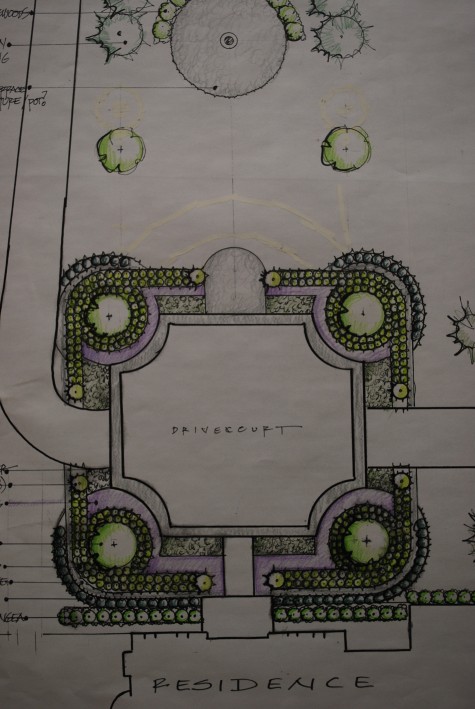 This drivecourt-of massive proportion and clear design-I have a mind to go along amicably, and reinforce its big statement. The big statement in any landscape-I would advise you to figure out what that statement is, and go for broke-in support. I come in contact with plenty of statements not of my choosing or design-this does not bother me in the least. Any existing big statement implies consent. I have no need to go back to the beginning. I like to put my weight to any idea a client felt comfortable consenting to. If you have inherited a landscape, what are the strong elements well worth keeping?
This drivecourt-of massive proportion and clear design-I have a mind to go along amicably, and reinforce its big statement. The big statement in any landscape-I would advise you to figure out what that statement is, and go for broke-in support. I come in contact with plenty of statements not of my choosing or design-this does not bother me in the least. Any existing big statement implies consent. I have no need to go back to the beginning. I like to put my weight to any idea a client felt comfortable consenting to. If you have inherited a landscape, what are the strong elements well worth keeping?
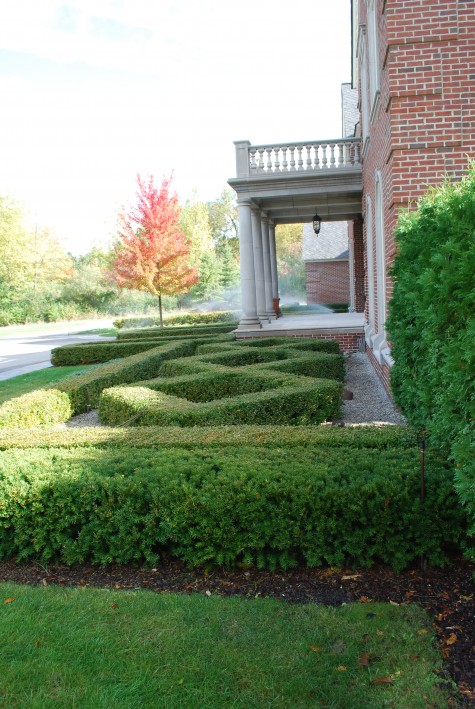 The both of them understood the difference between beautifully grown plants, and a beautiful landscape. We spent the better part of two hours going over their issues. Hopefully moving some plants, and adding a little of this and that will better serve them-and showcase all those beautiful plants.
The both of them understood the difference between beautifully grown plants, and a beautiful landscape. We spent the better part of two hours going over their issues. Hopefully moving some plants, and adding a little of this and that will better serve them-and showcase all those beautiful plants.
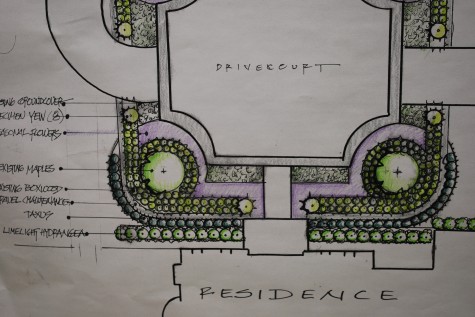
What they see, near and far, should provide visual exploration of the big picture.
The Bluewater Drawings
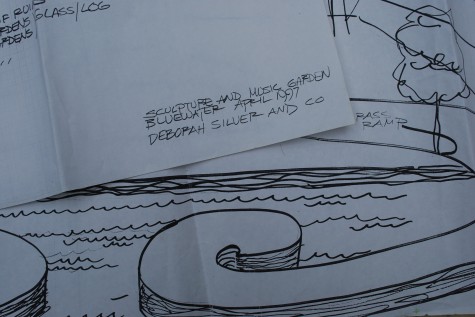 As my layout table has its first new coat of paint in 14 years, all the prints I’ve had stored there are piled up in my office. OK, I couldn’t resist taking a look before I put them back in storage. Some of them entertain me-I can see exactly what was influencing me at the time. The roll of drawings for the Bluewater project was just that-drawings. These unpolished sketches of landscape elements for a commercial project were highly conceptual-and certainly predate any computer programs that are now readily available to designers.
As my layout table has its first new coat of paint in 14 years, all the prints I’ve had stored there are piled up in my office. OK, I couldn’t resist taking a look before I put them back in storage. Some of them entertain me-I can see exactly what was influencing me at the time. The roll of drawings for the Bluewater project was just that-drawings. These unpolished sketches of landscape elements for a commercial project were highly conceptual-and certainly predate any computer programs that are now readily available to designers.
 Land forms have always been of great interest to me. A big chunk of my library deals with mazes and labyrinths, land sculpture and earthworks. Robert Smithson’s 1970 sculpture “Spiral Jetty”, constructed in 6 days on a leased piece of the Great Salt Lake in Utah, is now completely landlocked as the lake is so low. The sculpture spent 20 years or better completely submerged. The sculpture has presented in many forms over the past 40 years. I have always admired it; no doubt this conceptual drawing of a maze half in and half out of some water was directly inspired by Smithson’s work.
Land forms have always been of great interest to me. A big chunk of my library deals with mazes and labyrinths, land sculpture and earthworks. Robert Smithson’s 1970 sculpture “Spiral Jetty”, constructed in 6 days on a leased piece of the Great Salt Lake in Utah, is now completely landlocked as the lake is so low. The sculpture spent 20 years or better completely submerged. The sculpture has presented in many forms over the past 40 years. I have always admired it; no doubt this conceptual drawing of a maze half in and half out of some water was directly inspired by Smithson’s work.
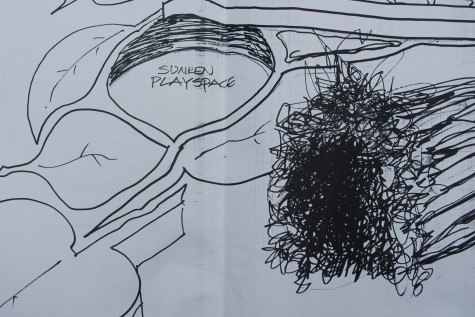 Another favorite-the land form drawings of Hans Dieter Schaal in his book “Landscape as Inspiration”. Inspired indeed. His sprawling and energetic drawings of natural forms exposed me to an entirely different way of thinking about dirt and nature. I had never seen landscape spaces rendered in this way before. I was equally taken with the beauty of the drawings. They are by no means scaled prints, they are gestural and interpretive marks on a page. This work inspired me to take up a marker and put it to a page, and see what happens. I refer to his book regularly.
Another favorite-the land form drawings of Hans Dieter Schaal in his book “Landscape as Inspiration”. Inspired indeed. His sprawling and energetic drawings of natural forms exposed me to an entirely different way of thinking about dirt and nature. I had never seen landscape spaces rendered in this way before. I was equally taken with the beauty of the drawings. They are by no means scaled prints, they are gestural and interpretive marks on a page. This work inspired me to take up a marker and put it to a page, and see what happens. I refer to his book regularly.
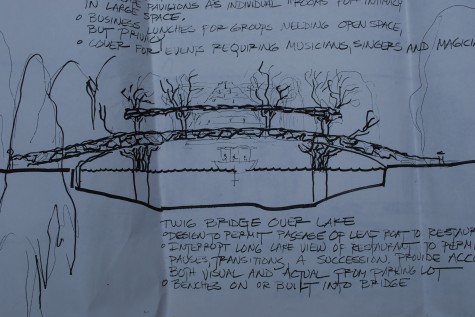 Any reference to natural forms intrigues me. A log twig bridge over Bluewater’s man-made lake seemed like just the right combination of architecture and natural materials. Buck shakes his finger at me when I design with no regard for construction, but I still think a little free spirited doodle drawing has its place. A sketch that seems to be going no where is easily discarded-provided you have not spent so much time with it that you have become attached. It is difficult to be objective about one’s own work-so I try to work fast at the conceptual stage. Anything I have invested a lot of time and work in can be hard to trash-even when trash it I should.
Any reference to natural forms intrigues me. A log twig bridge over Bluewater’s man-made lake seemed like just the right combination of architecture and natural materials. Buck shakes his finger at me when I design with no regard for construction, but I still think a little free spirited doodle drawing has its place. A sketch that seems to be going no where is easily discarded-provided you have not spent so much time with it that you have become attached. It is difficult to be objective about one’s own work-so I try to work fast at the conceptual stage. Anything I have invested a lot of time and work in can be hard to trash-even when trash it I should.
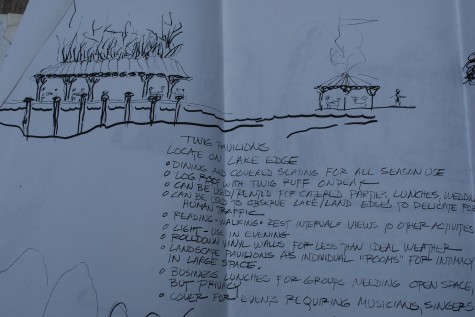 None of these drawings would convince a client to commit their time and money. But they might convince a client that there was a reservoir of ideas from which something of interest might emerge. If you don’t believe your designer is a person of interest, then a collaboration on your project is unlikely. If you are designing for yourself, drawings can bring ideas to the surface you didn’t know you had. Keeping a waste basket handy can be a comfort!
None of these drawings would convince a client to commit their time and money. But they might convince a client that there was a reservoir of ideas from which something of interest might emerge. If you don’t believe your designer is a person of interest, then a collaboration on your project is unlikely. If you are designing for yourself, drawings can bring ideas to the surface you didn’t know you had. Keeping a waste basket handy can be a comfort!
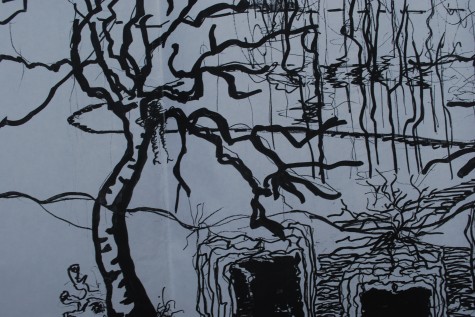 I am happy to have these drawings, not for their design, but for their energy. Being the fan of science that I am, I wholly subscribe to the notion that everything in motion tends to stay in motion-and what’s at rest tends to stay still. This applies as much to a design sensibility as it does to the physical world. Inertia being gravity that has gotten the upper hand, I make the effort to feed whatever energy I have regularly.
I am happy to have these drawings, not for their design, but for their energy. Being the fan of science that I am, I wholly subscribe to the notion that everything in motion tends to stay in motion-and what’s at rest tends to stay still. This applies as much to a design sensibility as it does to the physical world. Inertia being gravity that has gotten the upper hand, I make the effort to feed whatever energy I have regularly.
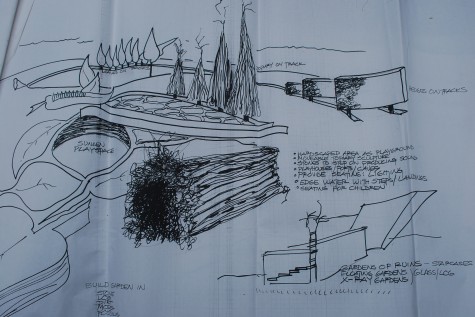 This drawing suggests at least 6 different ideas. They have similar elements, but are disconnected from each other. At the end of a series of drawings comes the integration phase. How visual and sculptural elements relate to each might be more important than any given piece. That relationship provides for good flow and rhythm. I see lots of landscapes that have good bits, but no flow. In the print, I plan for the transition between one space and another to have its own space.
This drawing suggests at least 6 different ideas. They have similar elements, but are disconnected from each other. At the end of a series of drawings comes the integration phase. How visual and sculptural elements relate to each might be more important than any given piece. That relationship provides for good flow and rhythm. I see lots of landscapes that have good bits, but no flow. In the print, I plan for the transition between one space and another to have its own space.

Once I was able to see that technically expert drawings did not necessarily imply expert concepts, I felt much more free to draw. The marks I make with the greatest confidence? My signature. Much of that confidence comes from having made those particular marks countless times. No one critiques a signature either-it is what it is. A series of drawings about your yard might need a little time to sit, before you review. It’s February-you have time.
